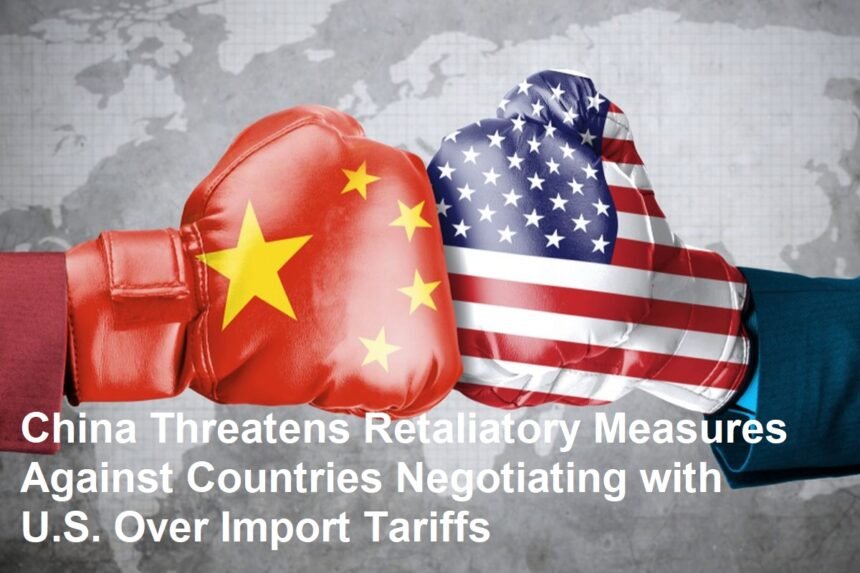In a sharp escalation of global trade tensions, China has issued a stern warning to countries engaging in negotiations with the United States to secure exemptions from recently heightened U.S. import tariffs. Chinese officials have labeled such negotiations as “economic collusion” undermining multilateral trade principles and threatened retaliatory actions, including tariffs, trade barriers, and economic sanctions, against nations that align with Washington’s policies. The move underscores Beijing’s determination to counter U.S. efforts to reshape global trade dynamics and protect its own economic interests amid simmering geopolitical rivalries.
Context of U.S. Tariff Hikes and Global Reactions
The Biden administration recently announced sweeping increases in tariffs on a range of imported goods, particularly targeting Chinese sectors like electric vehicles (EVs), solar panels, and semiconductors. These measures, framed as protecting American industries from “unfair competition” and “overcapacity,” build on earlier trade policies from the Trump era, which ignited a protracted U.S.-China trade war. However, the latest tariffs have also prompted U.S. allies and trade partners, including the European Union (EU), Japan, and South Korea, to seek exemptions or negotiate bilateral deals to avoid collateral damage to their economies.
China’s Ministry of Commerce condemned these negotiations as “opportunistic” and warned that countries seeking favorable terms with the U.S. would face “severe consequences.” A spokesperson stated, “Nations that prioritize short-term gains over fair and balanced trade will bear responsibility for destabilizing global markets.” Analysts interpret this as a direct challenge to U.S. efforts to isolate China economically and a bid to rally opposition against Washington’s unilateral trade measures.
China’s Retaliatory Toolkit
While China has not specified which nations might be targeted, experts suggest retaliatory measures could include:
- Tariffs on Key Exports: Countries reliant on the Chinese market, such as Australia (minerals), Germany (automobiles), or Southeast Asian nations (electronics), could face steep tariffs.
- Customs Delays and Regulatory Barriers: Heightened inspections or bureaucratic hurdles for goods from “non-cooperative” countries.
- Investment Restrictions: Curtailing Chinese overseas investment or canceling infrastructure projects under the Belt and Road Initiative (BRI) in nations siding with the U.S.
- Export Controls: Limiting access to critical materials like rare earth minerals, vital for technology and defense industries.
Such tactics mirror strategies China deployed during the 2018–2020 trade war, when Australian barley, wine, and coal faced crippling tariffs after Canberra backed a probe into COVID-19’s origins.
Global Concerns and Diplomatic Fallout
The threat has sparked alarm among U.S. allies, particularly those caught in the crossfire. South Korea and Japan, which rely heavily on both U.S. security partnerships and Chinese trade, have urged dialogue to avoid a “binary choice” between the superpowers. EU Trade Commissioner Valdis Dombrovskis reiterated the bloc’s commitment to “rules-based trade” but acknowledged the complexity of balancing relations with Washington and Beijing.
Developing nations, meanwhile, face heightened vulnerability. Countries like Vietnam and Indonesia, which have expanded exports to the U.S. amid supply chain shifts away from China, now risk retaliation if perceived as overly aligned with American policies.
Broader Implications for Global Trade
The standoff threatens to fragment the global trading system into competing blocs, with the U.S. and China pressuring nations to pick sides. The World Trade Organization (WTO) has repeatedly warned against tit-for-tat protectionism, noting that tariffs since 2018 have disrupted over $1 trillion in trade. Economists fear renewed conflict could further inflate consumer prices, disrupt supply chains, and stall post-pandemic recovery efforts.
Expert Warnings and Calls for Restraint
Trade analysts emphasize the risks of escalation. “China’s threats are a strategic deterrent, but actual retaliation would harm its own economic relationships,” said Li Yong, a Beijing-based trade expert. Others note that smaller economies may resist overt pressure, as seen in ASEAN’s push for neutrality despite U.S.-China rivalry.
However, diplomatic solutions remain elusive. The U.S. insists its tariffs are narrowly targeted, while China demands an end to “containment policies.” With the WTO weakened by stalled reforms, the absence of a neutral arbitration mechanism heightens the potential for conflict.
As the U.S. and China vie for economic dominance, the latest threats underscore a perilous reality: the global trade order is increasingly held hostage by superpower competition. For smaller nations, navigating this landscape requires precarious diplomacy to avoid antagonizing either side. Unless multilateral dialogue replaces unilateral threats, the world risks sliding into a new era of protectionism—one where economic alliances are dictated by coercion rather than cooperation. The coming months will test whether diplomacy can prevail over division.












